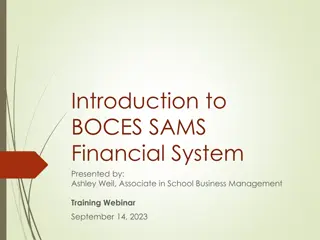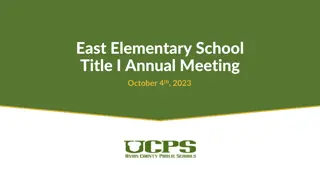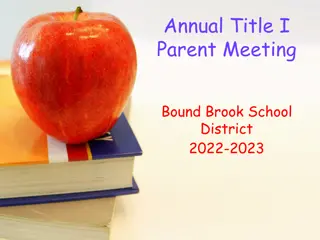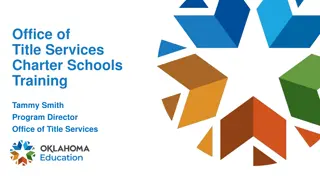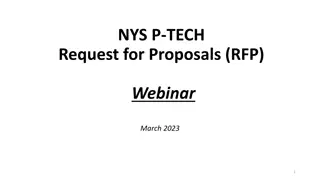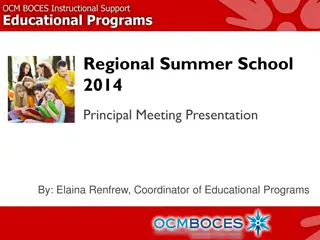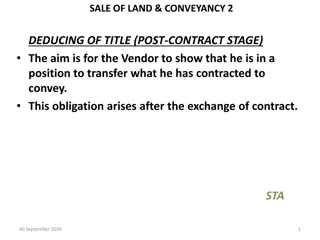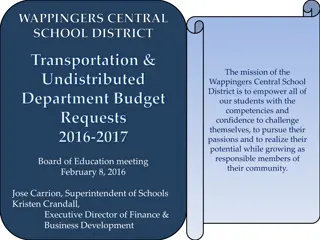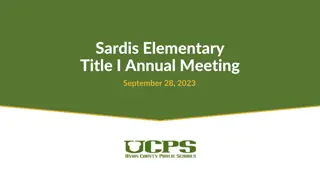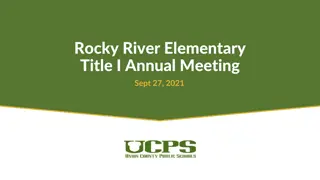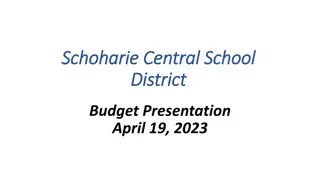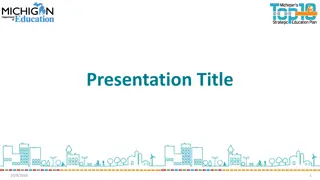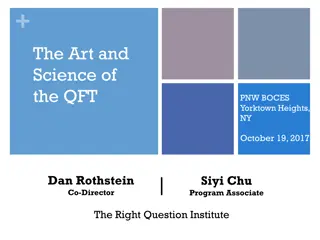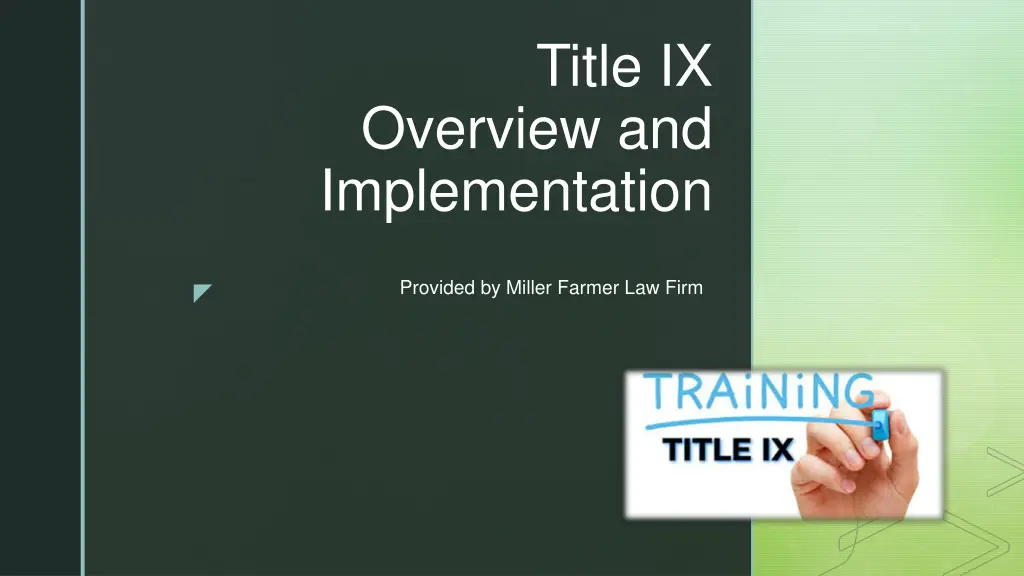
Title IX Overview and Implementation by Miller Farmer Law Firm
Explore a general overview of Title IX, provided by Miller Farmer Law Firm, covering its requirements, key concepts, new rules, compliance, roles, and types of interactions it covers. Learn about the significance of Title IX in preventing discrimination based on sex in educational settings receiving federal funds.
Download Presentation

Please find below an Image/Link to download the presentation.
The content on the website is provided AS IS for your information and personal use only. It may not be sold, licensed, or shared on other websites without obtaining consent from the author. If you encounter any issues during the download, it is possible that the publisher has removed the file from their server.
You are allowed to download the files provided on this website for personal or commercial use, subject to the condition that they are used lawfully. All files are the property of their respective owners.
The content on the website is provided AS IS for your information and personal use only. It may not be sold, licensed, or shared on other websites without obtaining consent from the author.
E N D
Presentation Transcript
Title IX Overview and Implementation Provided by Miller Farmer Law Firm
This presentation is meant to be a general overview and to requirements of Title IX. It is not legal advice, since every situation will be unique and different. Consult with your attorney to address specific situations. meet the training
Overview of Title IX What is Title IX? No person in the United States shall, on the basis of sex, be excluded from participation in, denied the benefits of, or be subjected to discrimination under any education program or activity receiving Federal financial assistance. What does sex mean? Male/Female (biological sex) Gender (identity) Stereotyping Sexual orientation Sex as a verb (i.e. sexual assault)
New Rules How They Came to Be Effective August 14, 2020 Most comments ever submitted for a proposed rulemaking An attempt to bring balance to Title IX responses (mostly at college campuses) Any formal reversal would take at least 1 year
Who Must Comply? Recipients of federal funds, including districts and charter schools
New Requirements Roles (Title IX Personnel) Title IX Coordinator Investigator Can be the Coordinator (be mindful of conflict/bias) May want to consider a back-up Decision-maker Cannot be the Coordinator or Investigator May want to consider a back-up Appeals Body/Officer Cannot be the Coordinator, Investigator, or the Decisionmaker May want to consider a back-up Informal Resolution Facilitator Must be trained/competent in resolving disputes
Types of Interactions that Could be Covered Student/Student Employee/Student Employee/Employee Could be applicants for enrollment or employment Not exhaustive, but most commonly
Notification/Publication Title IX Notification Title IX Coordinator Contact Information Who, What, When, Where? Title IX Coordinator s Name, Mailing Address, Email Address, and phone number Posted to Website, Handbook, Catalogs, so that Interested Persons (applicants, employment, students, parents/guardians, employees) can readily find
Policies How to report/file complaint Equal and fair treatment for complainant and respondent Objective evaluation of the evidence No Conflict of Interest of Bias for Title IX Personnel Start with presumption that respondent is innocent Reasonably Prompt Time Frames Range of Possible Disciplinary Sanctions and Remedies Remedies must be designed to restore or preserve equal access to the school s education program and activities. Standard of Proof (Preponderance of the Evidence OR Clear and Convincing), must apply to ALL cases Appeal procedures
Procedures/Processes Concerns/Reports Informal Complaints Formal Complaints Appeals Informal Resolution
All Staff Title IX Personnel Definition of Sexual Harassment Scope of the School s Education Program or Activity How to Conduct an Investigation and grievance process including hearings, appeals, and informal resolution process How to serve impartially, including by avoiding pre-judgment of the facts at issue, conflicts of interest, and bias Relevance Rape Shield Protections Decision-maker: Technology to be used at a live hearing Post Training Materials
Actual Knowledge means any employee notified of a violation is imputed to the School. So training on reporting is necessary for all employees. Important to note that employee s still have an independent obligation to report child abuse - so even if they ve reported for Title IX purposes, that doesn t cover them as a mandatory reporter (if warranted).
What is Sexual Harassment? Quid Pro Quo. An employee of the school conditioning the provision of an aid, benefit, or service of the school on an individual s participation in unwelcome sexual conduct. Unwelcome Conduct (Severe and Pervasive and Objectively Offensive) that effectively denies a person equal access to the recipients education program or activity. Examples: unwelcome or unlawful sexual advances, sexual touching, comments, jokes, depictions, stories, etc. Must be based on sex (see definition). Sexual assault, dating violence, domestic violence, or stalking
What is Sexual Harassment? Sexual assault A sexual assault means an offense classified as a forcible or nonforcible sex offense under the uniform crime reporting system of the Federal Bureau of Investigation, including as follows: Forcible Rape means the carnal knowledge of a person, forcibly and/or against that persons will; or not forcibly or against that person s will where the person is incapable of giving consent because of their youth or because of their temporary or permanent mental or physical incapacity Forcible Sodomy means oral or anal sexual intercourse with another person, forcibly and/or against that person s will; or not forcibly or against that person s will where the person is incapable of giving consent because of their youth or because of their temporary or permanent mental or physical incapacity.
What is Sexual Harassment? Sexual Assault with an object means the use of an object or instrument to unlawfully penetrate, however slightly, the genital or anal opening of the body or another person, forcibly and/or against that person s will; or not forcibly or against that person s will where the person is incapable of giving consent because of their youth or because of their temporary or permanent mental or physical incapacity. Forcible Fondling - means the touching of the private body parts of another person for the purpose of sexual gratification, forcibly and/or against the person s will; or not forcibly or against that person s will where the person is incapable of giving consent because of their youth or because of their temporary or permanent mental or physical incapacity Incest Non-Forcible sexual intercourse between persons who are related to each other within the degrees wherein marriage is prohibited by law. Statutory Rape Non-Forcible sexual intercourse with a person who is under the statutory age of consent.
What is Sexual Harassment? Dating Violence The term dating violence means violence committed by a person (A)who is or has been in a social relationship of a romantic or intimate nature with the victim; and (B)where the existence of such a relationship shall be determined based on a consideration of the following factors:(i)The length of the relationship. (ii)The type of relationship. And (iii)The frequency of interaction between the persons involved in the relationship.
What is Sexual Harassment? Domestic Violence The term domestic violence includes felony or misdemeanor crimes of violence committed by a current or former spouse or intimate partner of the victim, by a person with whom the victim shares a child in common, by a person who is cohabitating with or has cohabitated with the victim as a spouse or intimate partner, by a person similarly situated to a spouse of the victim under the domestic or family violence laws of the jurisdiction receiving grant monies, or by any other person against an adult or youth victim who is protected from that person s acts under the domestic or family violence laws of the jurisdiction.
What is Sexual Harassment? Stalking The term stalking means engaging in a course of conduct directed at a specific person that would cause a reasonable person to (A)fear for his or her safety or the safety of others; or (B)suffer substantial emotional distress.
What is Sexual Harassment? Sexual Assault, Dating Violence, Domestic Violence, and Stalking are not evaluated for severity, pervasiveness, offensiveness, or denial of equal education, because such misconduct is sufficiently serious to deprive a person of equal access. But it is evaluated for Scope of School s Educational Program or Activities
What is the Scope of a Schools Educational Program or Activities? On school property, including vehicles School sanctioned events School exercises substantial control over both the respondent and the context in which the sexual harassment occurs
The Schools Responsibility Respond promptly when actual knowledge of allegations is received Response can t be deliberately indifferent, i.e. clearly unreasonable in light of the known circumstances Take action to protect parties Investigate Inform law enforcement No retaliation Take appropriate remedial action, including discipline Take steps to stop the offenses in the future
Retaliation No recipient or other person may intimidate, threaten, coerce, or discriminate against any individual for the purpose of interfering with any right or privilege secured by title IX . . . or because the individual has made a report or complaint, testified, assisted, or participated or refused to participate in any manner in an investigation, proceeding, or hearing . . . Charging an individual with code of conduct violations that do not involve sexual harassment, but arise out of the same facts or circumstances as a report or formal complaint of sexual harassment, for the purpose of interfering with any right or privilege secured by Title IX constitutes retaliation.
Retaliation Complaints alleging Title IX retaliation should follow the same grievance process Charging an individual with a code of conduct violation for making a materially false statement in bad faith in the course of a Title IX grievance proceeding does not constitute retaliation; however a determination regarding responsibility, alone, is not sufficient to conclude that any party made a bad faith, materially false statement.
Record Keeping Maintain for 7 years All investigation records Appeal records Records of any informal resolution Training materials Confirmation of parties receipt and responses to all of the above
Complainant Terminology An individual who is alleged to be the victim of conduct that could constitute sexual harassment. Parents and guardians do not become complainants (or respondents) Respondent An individual who has been reported to be the perpetrator of conduct that could constitute sexual harassment
Formal Complaint Terminology A document filed by a complainant or signed by the Title IX Coordinator alleging sexual harassment against a respondent and requesting that the school investigate the allegation of sexual harassment A formal complaint may be filed with the Title IX Coordinator in person, by mail, or by electronic mail, by using the contact information required to be listed for the Title IX Coordinator, and by any additional method designated by the school. At the time of filing the complainant must be participating in or attempting to participate in the education program or activity of the School Schools may consolidate formal complaints when/if arising out of the same set of facts
Terminology Continued Supportive Measures Individualized services reasonably available that are nonpunitive, non-disciplinary, and not unreasonably burdensome to the other party while designed to ensure equal educational access, protect safety, or deter sexual harassment. Recipient Elementary and secondary schools, as well as post secondary institutions that receive federal financial assistance Informal Resolutions Must start with formal grievance process (tab found on school website) Parties voluntarily participate and provide written consent Consent can be withdrawn at any time (either party can choose to go back to formal) Informal processes are NOT permitted in employee to student allegations
Who Can File a Report or Informal Complaint? Any person at any time cannot be ignored Who is required to file or forward a report? All school employees when they observe, hear about, or have any notice of sexual harassment or allegations of sexual harassment.
Title IX Coordinator Receives Reports or Informal Complaints Contact alleged complainant/victim Discuss availability of supportive measures Consider wishes with respect to supportive measures Inform of availability of supportive measures, whether or not a formal complaint is filed Explain the process for filing a formal complaint Remain completely neutral
Who Can File a Formal Complaint? Complainant (or parent/guardian or other third party) Signed by Title IX Coordinator Would not doing so be unreasonable in light of the known circumstances?
Title IX Coordinators Responsibility in a Formal Complaint Process Provide to all known parties: Written notice of the allegations with sufficient time to prepare a response before any initial interview A copy of the grievance process The written notice must include: A statement that the respondent is presumed not responsible for the alleged conduct Inform the parties that they may have an advisor of their choice (i.e. an attorney, parent, counselor, etc.) Inform the parties that each may inspect and review all of the evidence. (Whatever is sent to one, must be sent to the other party) Inform the parties of any provision in the school s code of conduct prohibiting making knowingly false statements or submitting false information during the grievance process.
Continued Title IX Coordinators Oversight and Responsibilities Investigation Investigative Report Hearing (if one is held - not recommended for K-12) Decision-making process Determination Appeal Process
Dismissal of Formal Complaint Must be dismissed if (but can still be addressed under school s discipline code): Would not constitute sexual harassment, as defined, even if proved Did not occur in the school s educational program or activities, or Did not occur against a person in the United States May be dismissed in the school s discretion if: Complainant notifies the Title IX Coordinator in writing of a desire to withdraw the formal complaint or any allegation The respondent is no longer enrolled or employed by the school Certain circumstances prevent the school from gathering evidence sufficient to reach a determination as to the formal complaint or allegations
Informal Resolution Process Cannot be mandatory Cannot be offered until after formal complaint is filed Cannot be offered if the complaint is against an employee Must obtain voluntary written consent, with other specific requirements Mediation, restorative practices, and other alternative resolution procedures in limited circumstances. Approach carefully and ensure facilitators are trained in the methods being utilized.
Removal of Respondent Students: When necessary to protect the complainant or others from immediate threat to physical health or safety Must be based on an individualized threat and safety analysis May not be solely for emotional or mental health reasons After the removal, the school must give the student notice and an opportunity to challenge the removal Consider interplay with other laws (IDEA, etc.) Employees: Paid administrative leave at the discretion of employer/school (consider contractual issues for districts)
Supportive Measures Non-punitive individualized services offered as appropriate and without charge to a complainant or a respondent Must be designed to preserve educational access without unreasonably burdening the other party Schedule changes Class changes Course modifications Counseling resources Deadline extensions for assignments Mutual restrictions on contact Monitoring/supervision Online Learning Other
Assignment of Investigator and Decision Maker Follow policy guidelines for selection of these individuals (School Mandated Policies) Best if predetermined and not selected after the complaint is filed or received Title IX Coordinator serves to move the process
Conflict of Interest and Bias Investigator, Decision-maker, Appeal Body/Officer, Informal Resolution Facilitator must be free from conflict of interest and bias Regulations state flexibility to use their own employees, or to outsource Title IX investigation and adjudication functions, and the Department encourages recipients to pursue alternatives to the inherent difficulties that arise when a recipient s own employees are expected to perform functions free from conflicts of interest and bias Impartiality to perform duties based solely on the facts and evidence gathered during the investigation No bias No conflict of interest No prejudgment of parties or evidence
What is Bias? Bias: an inclination of temperament or outlook; bent or tendency (Merriam Webster s Dictionary). Whether bias exists requires examination of the particular facts of a situation. Apply an objective (whether a reasonable person would believe bias exists), common sense approach to evaluating whether a particular person serving in a Title IX role is biased. Avoiding Bias Avoid inferences based on party status athlete, trusted teacher, good student, high ranking official. Avoid sex stereotypes Avoid making assumptions Objectively evaluate all relevant evidence including both inculpatory and exculpatory evidence Evidence of Bias Jumping to conclusions, only hearing one side of a story, elevating favorable evidence and discounting unfavorable evidence, etc.
What is Conflict of Interest? Conflict of Interest: a conflict between the private interests and the official or professional responsibilities of a person in a position of trust or a conflict between competing duties (Merriam Webster s Dictionary). Matters to consider: Personal interests friendship, relatives, business partners, clubs and groups, school activities. Family members (obvious) Business relationships Workplace dynamics Close relationship to student/employee or his/her family, exercising caution not to apply generalizations that might unreasonably conclude that bias exists
The Investigation: Understanding Relevance Relevant evidence means evidence having any tendency to make the existence of any fact that is of consequence to the determination of the action more probable or less probable than it would be without the evidence (no definition in the regulations). Evidence that makes a material fact more or less likely to be true. Questions to ask: Is the evidence helpful in making a determination as to whether or not a fact is more or less likely to be true? Does this evidence help to prove or disprove anything material to the investigation?
Relevance Continued Cannot require disclosure of privileged information, including attorney-client communications, a party s medical, psychological, and similar records. Can only be used with that party s voluntary written consent. Rape Shield Protections Evidence about the complainant s sexual predisposition or prior sexual behavior are not relevant, unless: Such questions and evidence about the complainant s prior sexual behavior are offered to prove that someone other than the respondent committed the conduct alleged by the complainant; or If the questions and evidence concern specific incidents of the complainant s prior sexual behavior with respect to the respondent and are offered to prove consent.
Confidentiality Must keep confidential the identity of any individual who has made a report or complaint of sex discrimination, including any individual who has made a report or filed a formal complaint of sexual harassment, any complainant, any individual who has been reported to be the perpetrator, any respondent, and any witness except as: Permitted by FERPA Required by law Or to carry out the purposes of Title IX
The Grievance Process Reasonably prompt time frames 60 days deemed to be reasonably prompt Delays and extensions for good cause with written notice to the parties Absence of a party or party s advisor Law enforcement investigations Other accommodations Disciplinary Sanctions Evidentiary Standard Preponderance of the evidence (recommended) Clear and convincing evidence Policy Driven (Make certain grievance process is identifiable on website.)
Investigation Planning/Pointers Be objective and reserve judgment Investigation Plan Review complaint Review available evidence/statements Develop list of questions that need answers Organize the incident(s)/allegations into separate categories Elements needed to be proven for each possible act/violation Collect evidence to assist decision-maker in resolving disputed facts
Interviewing Order of interviews Usually accused interviewed last and complainant first Balance Sympathetic/Friendly of Accused (not only those persons suggested by complainant) Ask for additional interviewees, witnesses, and any corroborators Interviews Ask questions about the complaint, in different ways, confirm and re-confirm if all of the elements of misconduct have been met. Make sure details match. Ask for additional witnesses; who are the most important witnesses.
Interview Tips Start the interviews ASAP after incidents Make them comfortable, but don t be too friendly Explain your role as investigator (information-gathering, not decision-maker) Discuss confidentiality and its limits Discuss retaliation and its prohibition Discuss logistics of the interview process Inform witnesses that they can t be retaliated against; help them feel comfortable Maintain objectivity/poker-face Take good notes, or record if appropriate Hold the interview in a private, quiet location Open-ended questions; avoid yes/no or leading questions
Interview Tips Continued Do not interrupt witnesses while they are coming out with relevant information, don t be afraid of dead air, we want them to speak Start out with general/warm up questions, then graduate to more closely- focused questions to secure witnesses details Repeat important questions, but with different wording, to see whether the witness maintains their account Avoid confrontational or accusatory questions (i.e. leading questions) Pay attention to witnesses' body language, make note in report Use silence after a question as a technique to encourage reticent witnesses to start talking - people often feel a need to "fill in" periods of silence


